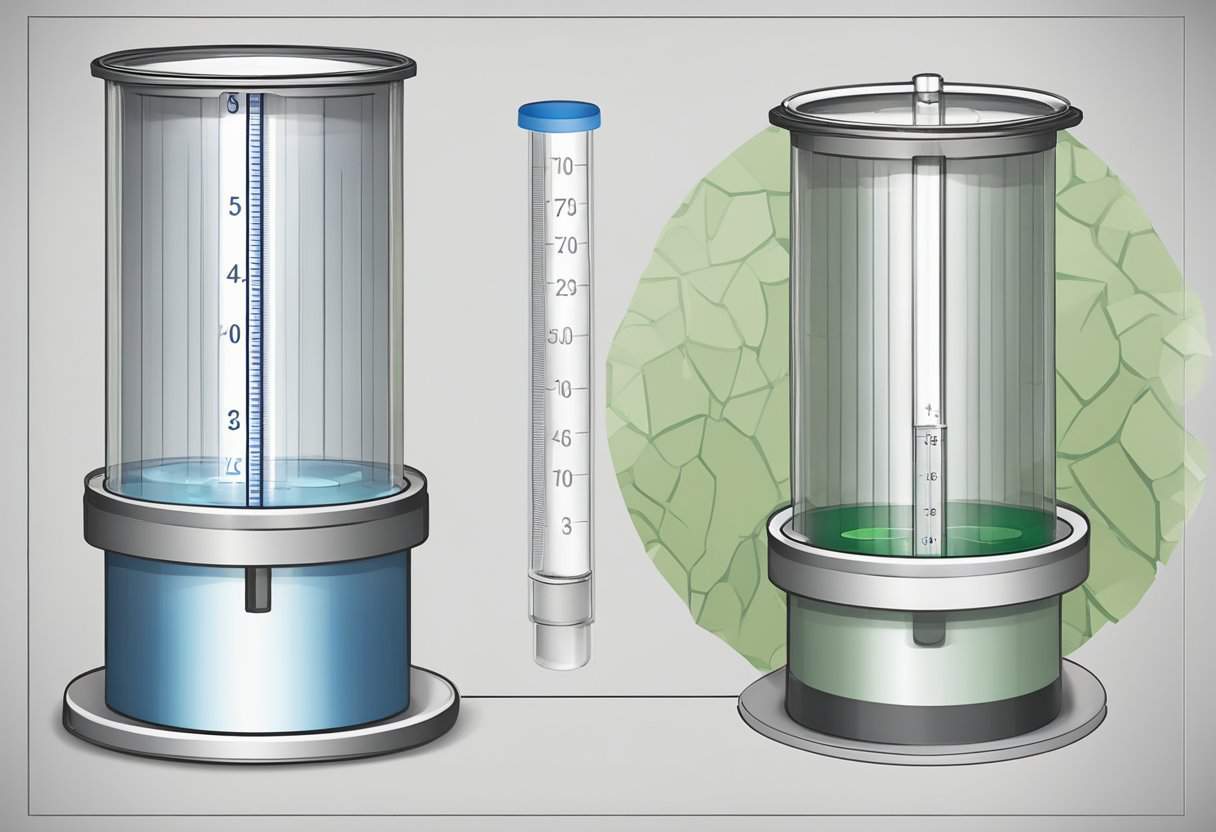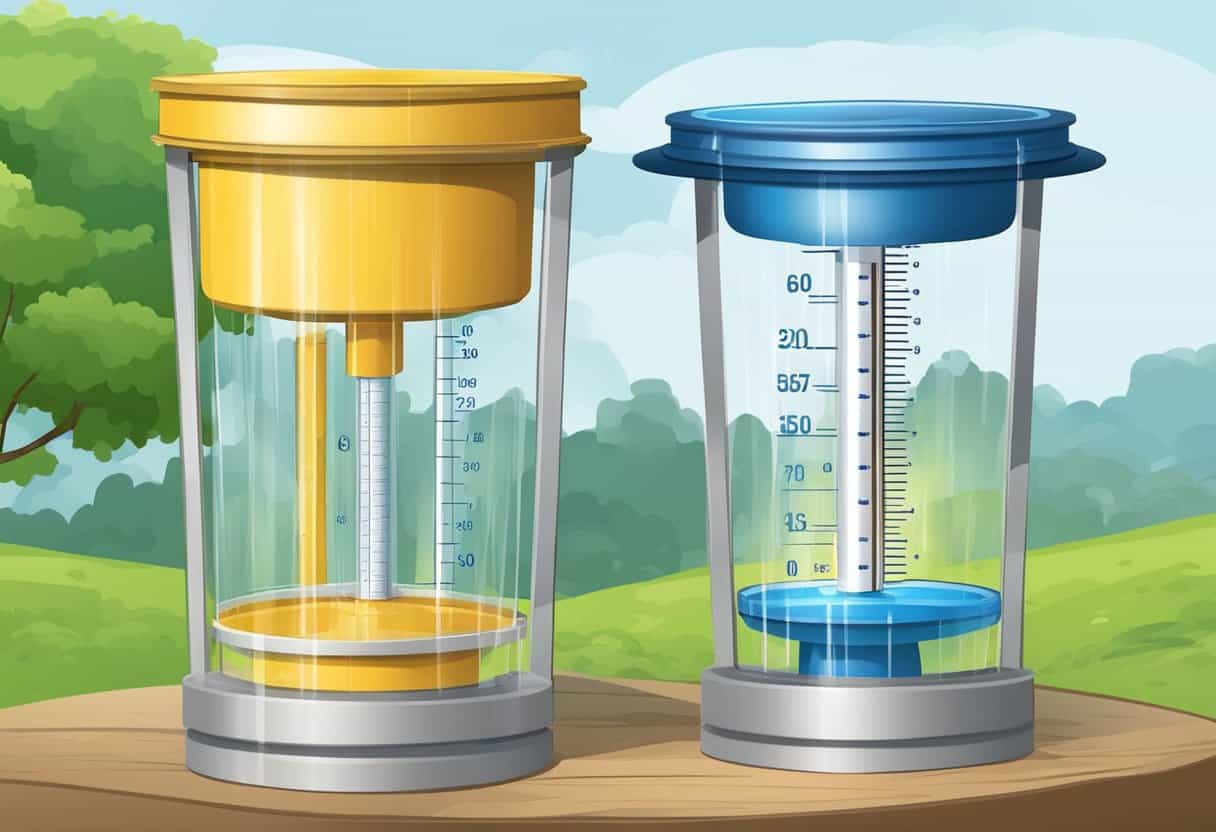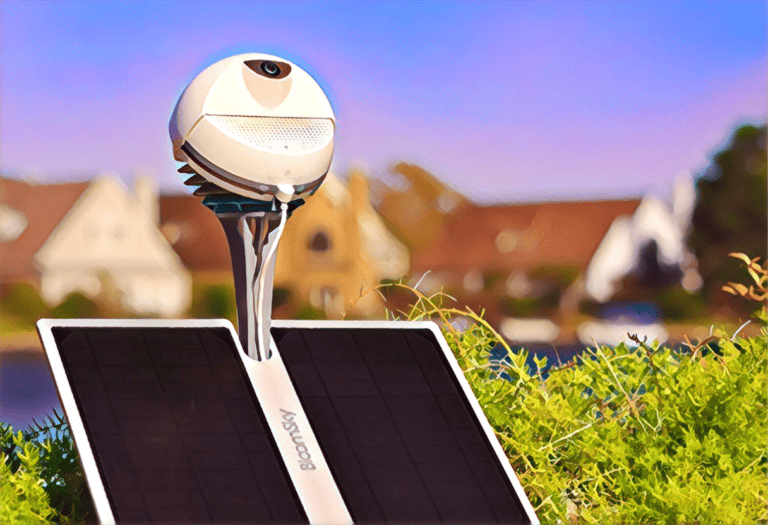A rain gauge is an instrument designed to collect and measure the amount of liquid precipitation over a set period of time.
This simple yet effective tool is essential for meteorologists and environmental scientists who track weather patterns and study climate change. Whether it’s a farmer assessing the rainfall to manage crop irrigation or an enthusiastic weather hobbyist recording data for personal interest, rain gauges play a vital role in providing accurate weather-related information.
Understanding how to read and interpret data from a rain gauge is critical for anyone interested in the natural environment. The placement of the gauge can significantly affect its accuracy, making it essential to consider the correct installation location.
Technical advancements and various types of rain gauges, from the basic manual collector to sophisticated electronic versions with wireless data transmission, offer a range of options for different needs and precision levels.
A rain gauge measures rainfall by collecting precipitation in a container and indicating the amount via a calibrated scale, essential for weather monitoring and environmental studies.
History of Rain Gauges
Understanding the history of rain gauges exposes a journey from simple concepts to intricate technology. This evolution reflects humanity’s ever-growing necessity for precise weather measurement.
Ancient Origins
In ancient times, civilizations recognized the importance of tracking rainfall for agriculture and survival. Your appreciation for weather measurement finds its roots with the Greeks and ancient India. As early as the 4th century BCE, Greeks used simple containers to collect rainwater and measure rainfall. These containers were possibly the precursors to the udometer, a term derived from Greek meaning “to measure” things related to water. In India, King Cheung invented a gauge made of bronze in the 2nd century BCE. This early device was a critical tool for agricultural planning.
Modern Developments
Transitioning to more recent innovations, ombrometer or pluviometer, are names you might identify with a rain gauge in today’s terminology. The development of gauges over time has led to the standardization of measurement techniques. One of the hallmark moments occurred when the father of hydrodynamics, Benedetto Castelli, a student of Galileo, advocated for quantitative measurement, emphasized by an article detailing the development of rain gauges. In the 17th century, he presented his findings to the Pope with the hope of utilizing a network of rain gauges to correlate rainfall with river levels.
The progression to automatic rain gauges, which record data over time without manual interference, marked a significant leap. This advancement is captured through an event analysis on January 10, 1994, showcasing the movement from manual readings to sophisticated, automatic water catching and calibration methods.
In recent years, rain gauge technology has expanded its capabilities, integrating with sensors and electronic systems to provide continuous, accurate measurements vital for weather forecasting, scientific research, and resource management.
Types of Rain Gauges
When you want to measure precipitation accurately, it’s essential to understand the different types of rain gauges available. Each design captures and measures rain in a unique way, providing data that can be vital for weather forecasting, scientific research, and agriculture.
Standard Rain Gauge
A Standard Rain Gauge is one of the simplest forms and is often used by meteorological services. This manual rain gauge consists of a cylindrical container with a funnel and a graduated measuring tube inside. When it rains, the water collects in the tube, and you can measure the amount by reading the scale, usually in millimeters or inches.
Tipping Bucket Rain Gauge
The Tipping Bucket Rain Gauge is an automated device that measures rainfall in a unique manner. It features a funnel that directs water into a small seesaw-like container, which tips over when filled with a set amount of precipitation. Each tip is recorded, usually electronically, allowing for real-time data collection of the amount of rainfall.
Weighing Rain Gauge
The Weighing Rain Gauge, like the universal weighing gauge, is more sophisticated. It has a storage container placed on a scale. The weight of the collected rain is recorded over time, which can be especially useful in areas with heavy precipitation since it’s not dependent on the mechanics of moving parts and is less likely to under-report in freezing conditions.
Optical Rain Gauge
Finally, the Optical Rain Gauge uses beams of light within a sensing area. When rain passes through, it distorts the light beam, and the gauge calculates the amount of rainfall by measuring the changes in light. This type typically provides very detailed data and can detect even small droplets, making it suitable for scientific studies.
Measuring Principles of Rain Gauges

Your understanding of how rain gauges function is crucial for accurate rainfall measurement. These devices typically consist of a collection system, measurement mechanics, and considerations for environmental factors that can affect accuracy.
Collection and Funneling
The key component of a rain gauge is its collection funnel. This component is designed to catch and direct rainwater into a measuring cylinder efficiently. You’ll find that the collecting funnel has a specific diameter, ensuring a uniform area for rainfall to enter. Typically, this funnel sits atop a graduated cylinder, a flask, or another type of measuring tube where the rainfall is collected and tallied.
Measurement and Recording
After rainwater is funneled, precise measurements are taken. Inside the unit, a narrow graduated cylinder or a measuring tube often serves to gauge the amount of rainfall. The graduations mark the rainfall measurement in millimeters or inches. Some more sophisticated gauges are equipped with automatic and electronic recording mechanisms to provide real-time data and longer-term rainfall measurement records without manual intervention.
Evaporation and Accuracy
To ensure accuracy, rain gauges must account for evaporation. The design of the receiving funnel and storage systems typically includes features that minimize water loss. Measures such as a moat around the collection cylinder and the addition of immiscible fluids help to prevent evaporation. Maintaining precise measurements involves regular calibration of rain gauges to account for any systematic errors or discrepancies.
Installation and Location Considerations
When installing a rain gauge, the primary factors you must consider are the placement and exposure to ensure accurate measurements. Ideal installation minimizes the impact of environmental factors such as obstructions and wind.
Placement in Open Areas
To achieve the most accurate rainfall data, your rain gauge should be placed in an open area. This location should be away from tall structures and trees which could skew the measurements by either blocking rain or causing additional moisture via dripping leaves. The open space allows the rain to fall directly into the gauge without any interference.
Avoiding Obstructions and Wind Interference
While finding an open space is crucial, it’s equally important to consider wind interference. Wind can cause significant errors by adding evaporative effects or by tilting raindrops away from the gauge’s opening. To counteract wind effects, the gauge should be installed at a height where the rim is level with or slightly above the ground—typically about two feet. Avoid placing your gauge near buildings, trees, or walls as these can act as windbreaks but also cause obstruction. For better protection and minimization of wind-induced errors, your gauge might be paired with windshields, though it’s essential to ensure they don’t become obstructions themselves.
Reading and Interpreting Rain Gauge Data
When you read rain gauge data, it is essential to understand the measurement units, analyze rainfall intensity, and compare the average rainfall to gauge precipitation accurately.
Understanding Measurement Units
Your rain gauge can measure precipitation in either inches or millimeters. This unit indicates the water level collected in the gauge. To read the gauge accurately, you should look for the meniscus, the curve seen at the water’s surface, and note the measurement where the meniscus lines up with the graduated markings on the rain gauge.
Analyzing Rainfall Intensity
Rainfall intensity is measured by noting the amount of rainfall over a specified period, typically in inches or millimeters per hour. Detectors within certain types of rain gauges can help determine this intensity by monitoring the rate at which the water level rises. A higher rise over a short period indicates a heavy rainfall, while a slower rise denotes light rain.
Comparing Average Rainfall
To understand the significance of a particular rain event, you need to compare it to the average rainfall for your area. You can determine average rainfall by accumulating readings over a specific time—monthly or annually—and then calculating the mean. This average, often expressed in inches or liters, helps in assessing whether a specific rainfall measurement indicates drought, normal, or excessive conditions.
Rain Gauges in Meteorology and Climatology
Rain gauges serve as critical meteorological instruments, providing accurate readings for rainfall monitoring. They are integral to both local weather stations and the broader operations of the National Weather Service.
Weather Prediction and Monitoring
You rely on weather prediction and monitoring to plan your day or prepare for severe weather conditions. Rain gauges provide real-time data on precipitation levels. At your local weather station or an automatic weather station, rain gauges collect and report rainfall measurements. These accurate readings are essential for meteorologists to analyze weather patterns and forecast conditions. The use of rain gauges helps in issuing timely warnings for floods and other weather-related hazards.
Climatology Use and Research
In the field of climatology, rain gauges are invaluable. Researchers studying long-term weather patterns use data from these devices to understand changes in climate. Over time, the accumulated data allows climatologists to identify trends in rainfall, influencing studies on water resources and the impact of temperature changes. Your insight into the effects of global climate phenomena relies on historic and continuous data collected by rain gauges, which inform both academic research and practical applications by organizations like the United States National Weather Service.
Rain Gauges and Environmental Science
Rain gauges play a pivotal role in environmental science by providing accurate measurements of rainfall. Your understanding of water-related processes and decisions in agricultural practices depend heavily on this data.
Hydrology and Water Cycle Research
Hydrologists rely on rain gauge data to study the water cycle and to understand precipitation patterns. The information you receive from these tools aids in modeling the distribution and intensity of rain. This is crucial because it influences our knowledge of groundwater replenishment, surface runoff, and the overall climate.
- Groundwater Replenishment: Measures the amount of rainfall that seeps into the ground.
- Surface Runoff: Records how much rain flows over land, potentially leading to floods.
Agricultural and Engineering Applications
In agriculture, rain gauges provide you with essential information that informs irrigation systems and helps to mitigate the effects of both droughts and floods. For engineers, the data from rain gauges are integrated into the design of water resource management projects, such as dams and drainage systems.
- Irrigation Management: Tailoring schedules to the actual water needs of crops, promoting efficiency.
- Flood Prevention: Assisting in the design of infrastructure that reduces the impact of heavy rainfall.
Volunteers, along with professionals, contribute to the collection of rain gauge data, which can be used by you in a multitude of applications and have a significant impact on environmental management and policy.
Maintenance and Troubleshooting
Ensuring accurate rainfall measurements from your rain gauge involves regular maintenance and prompt attention to potential issues. Proper care helps to avoid data inaccuracies due to environmental factors or equipment malfunctions.
Regular Cleaning and Calibrations
Regular cleaning is essential to maintain the accuracy of your rain gauge. Debris such as leaves and insects can clog the funnel or collector, leading to incorrect rain accumulation data. At least once a month, remove any visible debris and make sure the collector is clear and the measuring tube is clean.
Calibrations should be conducted periodically according to the manufacturer’s recommendations to ensure the gauge is measuring accurately. This usually involves comparing the readings of your gauge with a known amount of water to check for consistency.
Dealing with Snow, Ice, and Debris
In cold climates, snow and ice can cause issues for rain gauges. You may need to melt the snow or ice within the collector to measure the liquid water equivalent. Use warm water to gently melt any frozen precipitation, but take care to record the amount of water you use to avoid skewing the measurement.
During storms, heavy rain can lead to overflow, and hail can damage the collector. It’s important to check your rain gauge after such events for any necessary repairs or cleaning. Remove any hail, ice, or storm debris that might have accumulated in or around the gauge to keep it functioning properly.
Technological Advancements in Rain Measurement
Rain measurement technology has seen significant improvements over the years, introducing more precise ways for you to capture and analyze rainfall data.
Wireless and Electronic Gauges
Your understanding of rainfall data can be greatly enhanced with the use of wireless weather stations. These modern systems often include an electronic rain gauge which allows for the real-time transmission of data without the need for manual observation. Not only do these gauges accurately measure the amount of rainfall, but they can also provide valuable insight into weather patterns through data analytics.
- Features of Wireless Electronic Gauges:
- Real-time data transmission
- Automated recording and analysis capabilities
- Easy integration with other weather observation equipment
These gauges often come as part of a more extensive system that can monitor various weather parameters, offering a comprehensive view of the climate in your area.
Satellite and Laser Technologies
The integration of satellite and laser technologies has revolutionized how you monitor precipitation events on a global scale. Satellite-based sensors can cover vast areas, providing a big-picture view of rainfall that would be impossible to gather through ground instruments alone. Furthermore, with advanced methodologies like those involved in the Tropical Rainfall Measuring Mission (TRMM), your ability to analyze and predict weather patterns is more refined than ever.
- Satellite and Laser-based Measurement Techniques:
- Expansive coverage, ideal for remote or difficult-to-reach areas
- High-precision laser instruments, such as those used in LIDAR (Light Detection and Ranging) systems, offer detailed observations of precipitation structure
The use of these advanced tools can significantly improve the accuracy of rainfall measurement, especially in areas where traditional gauges are sparse. By analyzing the information collected from a combination of weighing precipitation gauges and remote sensing technologies, you have a much more reliable understanding of rainfall patterns and quantities.
Frequently Asked Questions
Understanding the tools used to measure rainfall and their effectiveness helps in accurate weather forecasting and resource management.
What type of instrument is used to measure rainfall?
A rain gauge is the standard instrument used to collect and measure rainfall. It consists of a funnel leading to a graduated cylinder that records the amount of liquid precipitation over a set period.
How can one accurately measure rainfall amount at home?
To measure rainfall at home accurately, ensure that your rain gauge is placed in an open area away from buildings or trees. Periodically, check the collected water and use the marked measurements on your gauge to record the rainfall amount.
In what units is rainfall typically measured?
Rainfall is typically measured in millimeters (mm) or inches, representing the depth of water that collects on a flat, impermeable surface.
What does the measurement of one inch of rainfall signify?
One inch of rainfall signifies that a one-inch depth of water has fallen over a one-square-inch area, equivalent to approximately 0.62 gallons of water per square foot.
How can you determine if a rain gauge provides precise measurements?
To determine if a rain gauge provides precise measurements, check the gauge for any debris or obstructions and ensure it’s correctly calibrated. Compare your readings against nearby weather stations for consistency.
How much rainfall can a typical rain gauge collect?
A typical rain gauge can collect sufficient rainfall to measure up to 10 inches. Certain gauges may have larger capacities depending on their design and intended usage.







